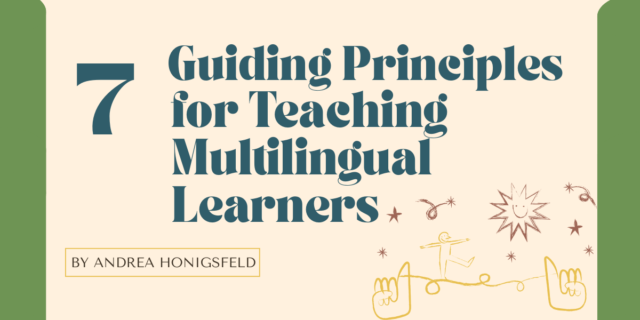
The English Language Arts (ELA) classroom can be an intimidating place for an English Learner (EL). As teachers of reading and writing, we all work hard to make sure every one of our students, particularly our EL students, is welcomed and included. There is no one way to create this kind of learning environment—the process is nuanced, complicated, and differs from teacher to teacher and classroom to classroom. We know there is already a huge range of strategies and differentiation tools at teachers' disposal, and as firm believers in having as many tools in our toolkits as possible, we propose a particular tool that we think has a lot of potential to create environments where our ELs are intentionally included into our classwork. We believe that asking students to read sound texts is a powerful, but undervalued and underutilized, tool for teachers to use when building inclusive, multimodal ELA classrooms for our EL students.
A text that has been written using the mode of sound or the audio mode offers students a wealth of opportunities to strengthen and develop their reading skills. These texts include genres like podcasts, audio dramas, radio ads, songs, etc. While some of these texts may integrate other modes—visual logos for podcasts or album covers for examples—the primary, meaning-making mode in a sound text is sound, and students can strengthen their reading skills with sound texts in important ways. For example, when we ask students to perform tasks, like thoughtful character or theme analysis in an audio drama, outlining an argument in a podcast, or identifying tone in a speech, they do so based entirely on the recorded sounds they hear in the selected text.
There is a wealth of research on the benefits of reading sound texts for all students, including promoting grammar awareness, more authentic motivation and interest levels, and stronger language comprehension (Folse; Echavarria et al.; Brady-Myerov). However, sound texts also provide the additional benefit of meeting our EL students’ right to be honored and included in our classwork together in a variety of ways. One of the biggest ways reading sound texts invites our EL students into our classwork is through sound’s capacity to differentiate important skills and assignments without emphasizing the differences between our EL and non-EL students. Tools like sentence frames or graphic organizers provide students with important and needed support, but often still identify EL students as needing separate materials from their classmates, at the risk of isolating them as “different.” The nature of sound texts, however, inherently integrates a variety of supports for ELs that might reduce reliance on these separate differentiation tools. By their very nature, sound texts are embedded with naturally occurring differentiation tools and features that are equally available to all students; these texts particularly benefit and support ELs’ comprehension as they work alongside their peers to develop their reading and writing skills.
Sound texts often come pre-loaded with a bevy of options and features that all students, and EL students in particular, might find useful and that naturally differentiate the reading skills needed to access the text:
- Many sound texts have accompanying, high quality transcripts which offer an authentic and meaning-rich alternative to accessing the content of a sound text.
- Most devices on which students and teachers play and listen to sound texts have options for slowing the speed of the recording; where EL students may feel self-conscious asking for a speaker to speak more slowly or for a reader to repeat a particular line, ELs can adjust their listening speeds to support comprehension.
- Intentional sound texts also rely on more than just spoken words to convey meaning; podcasts, audio dramas, speeches, and many other sound genres also make strategic use of valuable context clues for ELs who work to decipher the text. These cues include things like the “embed[ding] of appropriate volume, tone, emphasis, phrasing and other elements in oral expression” (Calderón 21).
Using sound texts, teachers are able to create curricula using rigorous texts, while including EL students more naturally and comfortably, minimizing differences between peers, promoting collaboration and connection, and allowing ELs to develop their skills alongside their non-EL peers on a more even playing field. We still wholeheartedly recommend making all the traditional differentiation tools available to students when reading sound texts; however, we believe that reading in the mode of sound can empower our ELs and invite them into a more comfortable and accessible collaboration with their peers based on the features sound texts offer.
When designing reading assignments using sound texts, the choices we make as teachers around which texts to use is an equally important element of promoting inclusivity for our ELs for a few reasons:
- Sound texts offer a unique opportunity for students to hear and engage with voices speaking in languages other than English. They showcase a vast diversity of forms of the English language, since certain genres of sound texts, such as interviews, podcasts, and music, are “most effective when they integrate the use of diverse varieties of English, code-switching, other languages, or accents” (Mooney and Hashem). This gives our EL students a chance to observe that a variety of forms of the English language are valid, valuable, and worthy of study.
- While other modes can certainly access this linguistic diversity, sound text genres often do it more organically. The capacity to literally hear the human voice speaking certain words helps students to emotionally connect with the speaker and acknowledge the speaker’s shared humanity. Erin Anderson’s work on the human voice and its impact on listeners points out that the sound of human speech is unique because it is “produced by and emitted from the human body. Inevitably, when we hear a voice, we hear a body.” This means that reading intentionally selected sound texts can not only expose students to a wide diversity of cultural language patterns, but it can also do so in a way that humanizes these voices and encourages empathy.
Reading sound texts allows our ELs to see that a diversity of cultures, ethnicities, and language varieties is celebrated in our classrooms, ensuring all students of all backgrounds are represented in our classwork.
One of the best things about including effective strategies in our classrooms is that those strategies benefit everyone in that classroom and not just EL students; what supports ELs also supports all our students. While using sound texts to teach reading may be something that helps your EL students feel more included in your classroom community, culture, and curriculum, reading sound texts as a class is for all your students looking to build flexible, relevant, and multimodal reading skills in ways that are engaging and practical.

Danah Hashem teaches world literature and AP Language at the high school level and writing at the undergraduate level while also pursuing her passion for and scholarship in digital literacies, audio rhetoric and composition, and student-centered learning. She believes deeply in the transformative potential of the mode of sound to amplify and empower student voices in the reading and writing classroom, and her work both in and outside of the classroom most frequently centers around this goal.
Anne Mooney teaches English at Malden High School in Malden, MA. Her academic interests of digital literacies, multimodality, and trauma theory have inspired both her classroom and her scholarship.
Works Cited
Anderson, Erin. 2014. “Toward a Resonant Material Vocality for Digital Composition.” enculturation: a journal of rhetoric, writing, and culture. August 18. http://enculturation.net/materialvocality.
Brady-Myerov, Monica. 2021. Listen Wise: Teach Students to Be Better Listeners. San Francisco, CA: Jossey-Bass.
Calderón, Margarita. 2007. Teaching Reading to English Language Learners, Grades 6-12. Thousand Oaks, CA: Corwin Press.
Echevarría, Jana, MaryEllen Vogt, and Deborah J Short. 2013. Making Content Comprehensible for English Learners: The SIOP Model. New York: Pearson.
Folse, Keith S. 2009. Keys to Teaching Grammar to English Language Learners: A Practical Handbook. Ann Arbor, MI: University of Michigan Press.
Mooney, Anne and Danah Hashem. 2020. “Using Sound Texts in AntiracistTeaching.” Edutopia. July 23. https://www.edutopia.org/article/using-sound-texts-antiracist-teaching.


